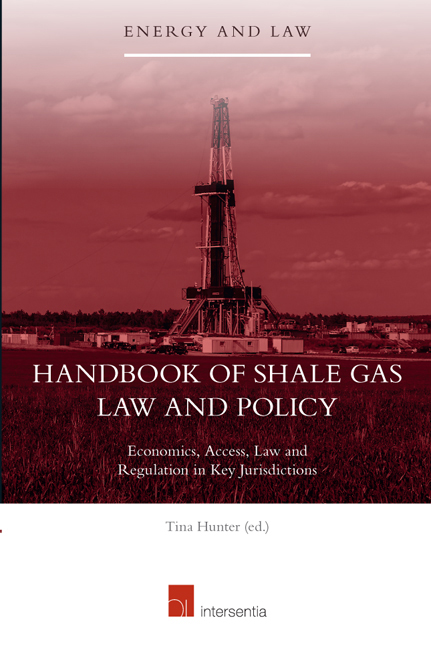Book contents
- Frontmatter
- Preface
- Contents
- List of Tables and Figures
- List of Authors
- Part I Overview and Introduction to Shale Gas Activities
- Introduction
- Shales, Shale Gas and Hydraulic Fracturing
- Hydraulic Fracturing in Shale Gas Operations: Risk and Response in Shale Gas Policy
- Part II Shale Gas Economics and Energy Security
- Part III Access to Shale Gas Resources
- Part IV Shale Gas Law and Regulation
- Part V The Future of Shale Gas in the United Kingdom
- Index
Introduction
from Part I - Overview and Introduction to Shale Gas Activities
Published online by Cambridge University Press: 21 September 2018
- Frontmatter
- Preface
- Contents
- List of Tables and Figures
- List of Authors
- Part I Overview and Introduction to Shale Gas Activities
- Introduction
- Shales, Shale Gas and Hydraulic Fracturing
- Hydraulic Fracturing in Shale Gas Operations: Risk and Response in Shale Gas Policy
- Part II Shale Gas Economics and Energy Security
- Part III Access to Shale Gas Resources
- Part IV Shale Gas Law and Regulation
- Part V The Future of Shale Gas in the United Kingdom
- Index
Summary
INTRODUCTION
Some say there is a revolution afoot. Others say rather than a revolution, it is more of an evolution. Whether revolution or evolution, it is taking place not in the east, but in the west. Its instrument of implementation is the drill, and the spoils are an abundance of gas to meet the needs of the hungry consumer, and to contribute to energy security, particularly for those countries lacking other forms of petroleum.
Shale gas is seen by many energy hungry countries as an important part of the energy mix, as well as being viewed as a ‘transition fuel’ from coal to lowcarbon alternatives, demonstrated by a recent UK study which showed that shale gas has a significantly lower carbon footprint than coal when used for electricity generation. This is particularly important in countries such as the USA, and many eastern European countries. For other countries such as Australia, which is endowed with generous conventional gas resources, the development of shale gas is targeted largely for the export market (in the form of liquefied natural gas, or LNG), contributing to Australia likely becoming the largest LNG exporter by 2030.
As new technologies and materials are developed and existing technologies harnessed to extract the substantial shale gas resources, shale gas is becoming an increasingly important source of energy. This has been particularly evident in the USA, where in the last ten years 5–9 trillion cubic feet (tcf) of unconventional gas has been produced annually. In comparison, gas production from conventional petroleum resources in the Gulf of Mexico has declined, with only 2–3 tcf produced annually since 2005. This represents a major increase in unconventional gas production, now representing 25% of total US gas production and increasing annually, with shale gas production developing all the time. Australia contains vast reserves of unconventional gas.
In the late 1990s and early 2000s a number of technological innovations that had been developed in the 1970s and 1980s by oil companies, in partnership with the US government, were combined and used on several shale formations in the USA, with spectacular results.
- Type
- Chapter
- Information
- Handbook of Shale Gas Law and PolicyEconomics, Access, Law and Regulation in Key Jurisdictions, pp. 3 - 12Publisher: IntersentiaPrint publication year: 2016



